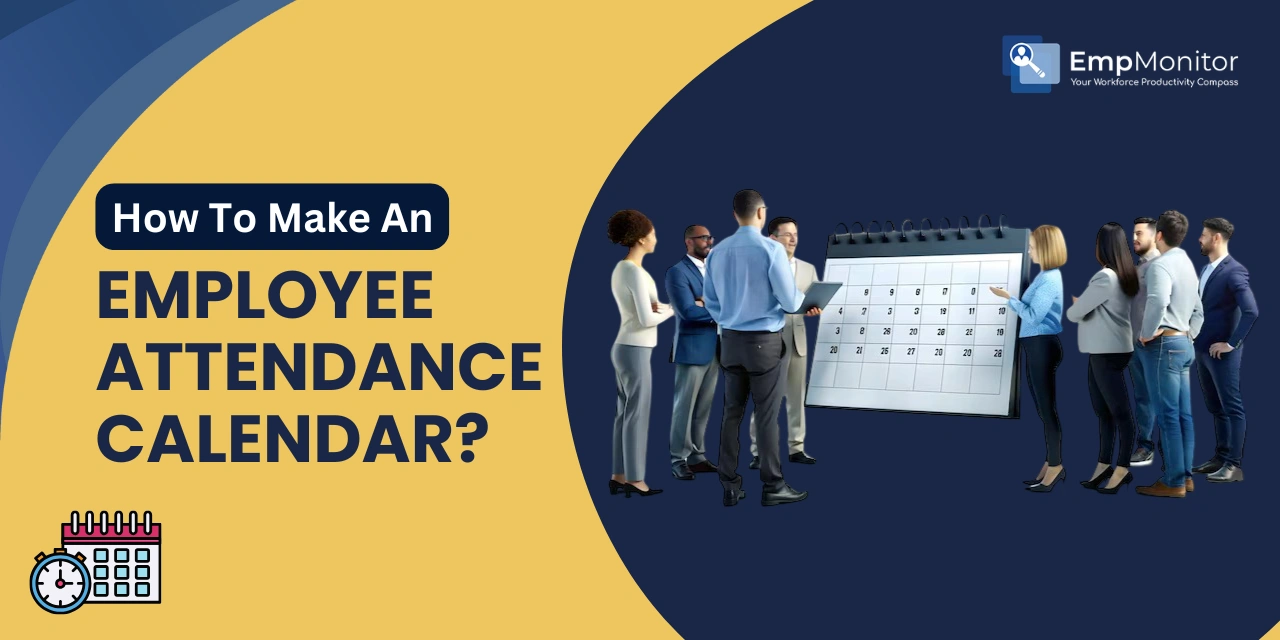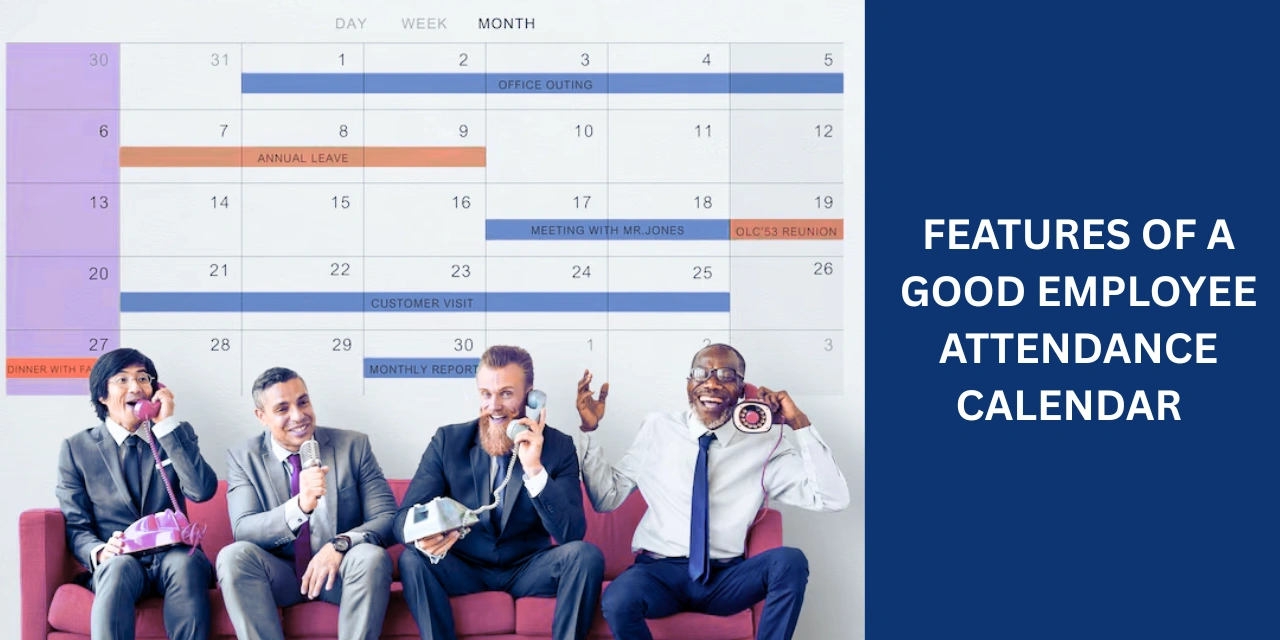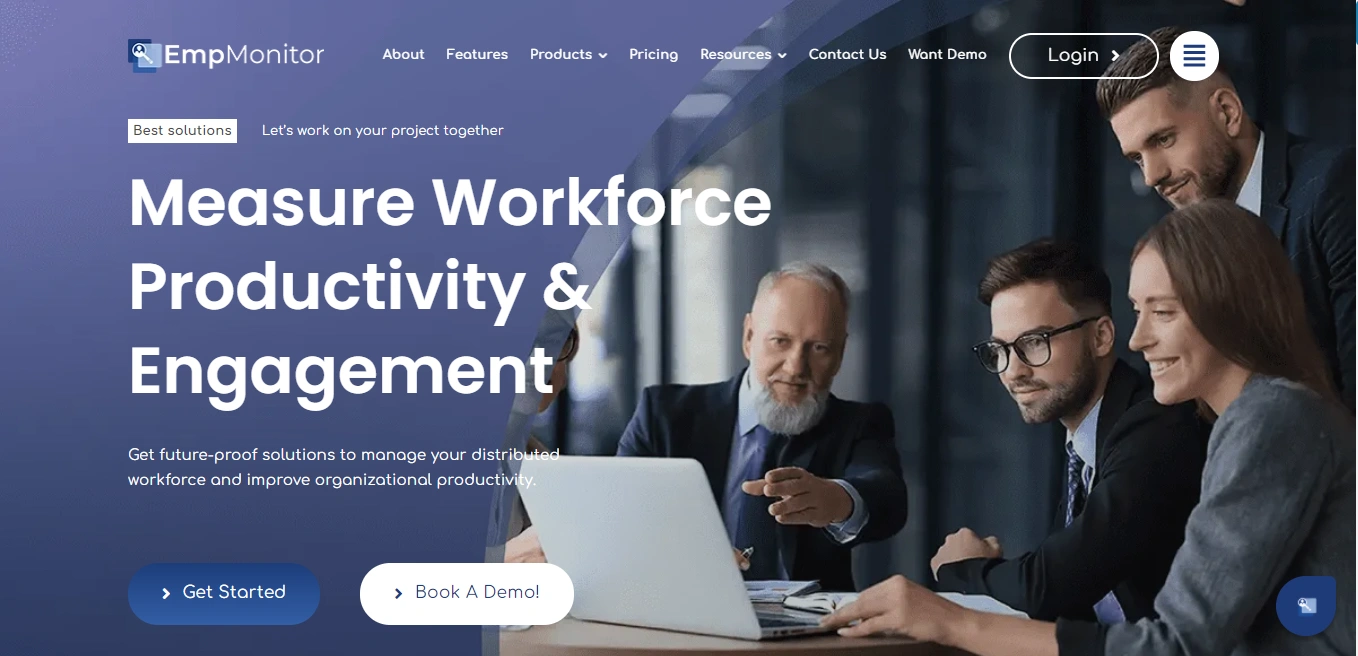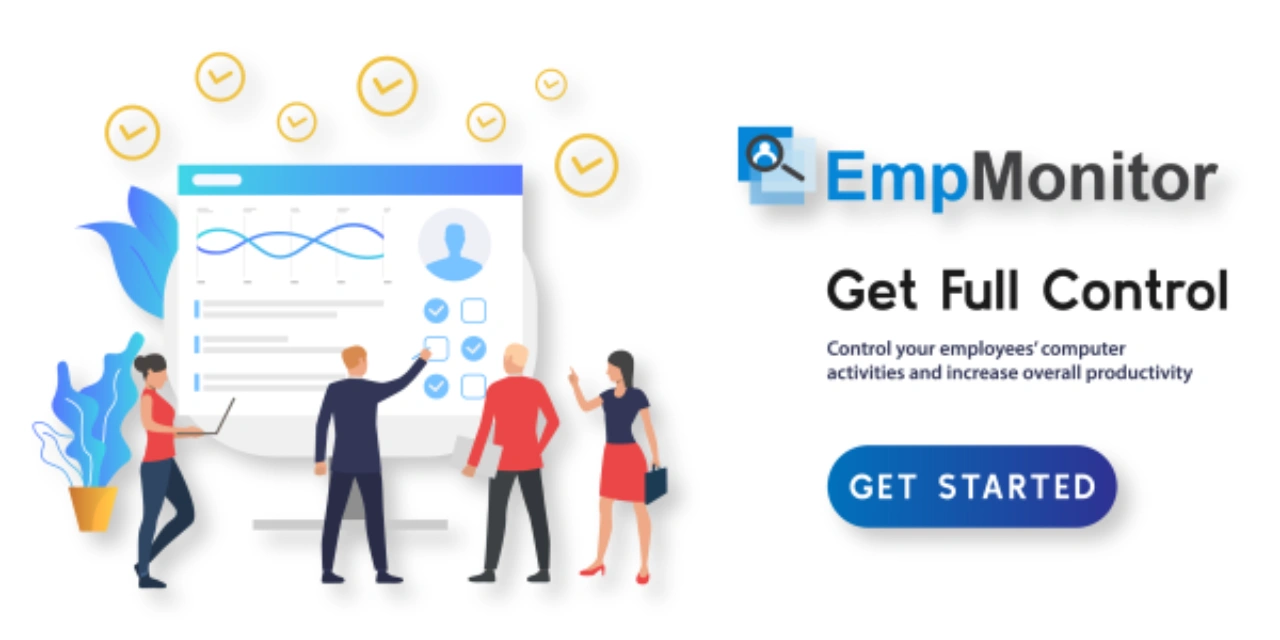Keeping track of when employees show up and leave might seem simple, but it’s a key part of running a successful business. Whether you’re running a small startup or managing a large organization, a well-organized employee attendance calendar is essential for keeping teams on track, reducing confusion, and ensuring accountability. It plays a key role in streamlining daily operations, enhancing productivity, and fostering a culture of transparency and discipline.
This guide will walk you through everything you need to know from the benefits and key features of an effective attendance calendar to templates, tools, and future trends to help you stay ahead.
In a hurry? Listen to the blog instead!
What Is An Employee Attendance Calendar?
An employee attendance calendar is a structured visual tool used to track, monitor, and manage the presence, absence, and leave status of employees. It shows detailed information about working days, holidays, sick leaves, vacations, late entries, and more. Unlike traditional manual tracking, a digital employee attendance calendar allows real-time updates and analytics, ensuring accurate record-keeping and better planning.
It also helps HR departments generate reports effortlessly, improves transparency between managers and staff, and supports compliance with labor regulations. Additionally, it aids in forecasting workforce availability for upcoming projects, allowing for smarter scheduling and resource allocation. Whether used by small businesses or large enterprises, it significantly boosts efficiency and minimizes attendance-related disputes.
Why Is An Employee Attendance Calendar Important?
Keeping track of employees’ attendance is essential for maintaining productivity, transparency, and compliance. Here’s a more in-depth look at why an employee attendance calendar is so important:
Boosts Efficiency: Automating attendance tracking helps HR avoid time-consuming manual entries and reduces dependency on spreadsheets. This streamlining of daily operations allows teams to focus on higher-value tasks like talent management and employee engagement.
Enhances Accountability: When employees know their attendance is monitored, they become more punctual and mindful of their time off. This promotes a culture of responsibility and discipline across the workforce.
Supports Legal Compliance: Labor laws require accurate documentation of work hours, leave, and overtime. A digital attendance calendar ensures you stay compliant by keeping records that can be easily audited or referenced.
Ensures Payroll Accuracy: Attendance data directly affects payroll. With automated tracking, calculations for paid time off, overtime, and deductions become error-free, ensuring employees are compensated fairly and on time.
Improves HR Processes: From leave approvals to generating monthly reports, having all attendance data in one centralized system simplifies HR operations. It eliminates redundant steps and shortens turnaround time for administrative tasks.
Reduces Manual Errors: Manual data entry is prone to mistakes, especially in large organizations. An attendance calendar with automation ensures accuracy and integrity of records, reducing the risk of payroll or compliance issues.
Enables Better Planning: Real-time visibility into who is in or out helps managers allocate resources more effectively. It also helps with long-term project scheduling and prevents staffing shortages during critical phases.
Increases Transparency: Giving employees access to their attendance records encourages openness and builds trust. It allows them to keep track of their leave balances and resolve discrepancies before they become issues.
Also Read!
How To Create An Attendance Sheet In 2025(+ Free Template)
How Businesses Use Timesheet Templates To Save Time & Money?
How To Build Employee Attendance Policy That Actually Works In 2025?
What Are The Features of a Good Employee Attendance Calendar?
Not all attendance calendars are built the same. A good calendar should include the following features:
1. Customizable Views
Everyone works differently, so flexibility in viewing attendance is key. A good system lets you switch between daily, weekly, or monthly views, making it easier to spot patterns and plan effectively based on your role or needs.
2. Leave Management
Managing time off becomes effortless when employees can request leave directly through the system and managers can approve it instantly. It keeps the process transparent and ensures that no requests slip through the cracks.
3. Automated Notifications
Nobody likes chasing down approvals or discovering missed punches too late. Automated alerts keep employees and managers in the loop about absences, leave approvals, and any violations, making communication seamless and timely.
4. Integration
An effective employee attendance calendar should connect effortlessly with payroll software, project management tools, and internal communication platforms. This centralizes operations and eliminates the hassle of managing separate systems.
5. Mobile Accessibility
In a world where work happens everywhere, being able to access and update attendance from a smartphone is a game-changer. Mobile access empowers remote and on-the-go employees to always stay connected and accountable.
These features ensure the employee calendar serves as more than just a record; it becomes a tool for strategic decision-making.
How To Create An Employee Attendance Calendar?
Creating an employee attendance calendar isn’t complicated if you follow the right steps.
Step 1: Identify Business Requirements
Start by understanding your organization’s specific attendance tracking needs. Are you monitoring sick leaves, late arrivals, or hybrid work schedules? Clarifying this upfront helps you choose the right tools and avoid gaps in tracking.
Step 2: Choose a Format
Think about what works best for your team. Simple spreadsheets might work for smaller companies, while growing teams may benefit from cloud-based apps or full-fledged HR systems. The format should align with your workflow and scalability needs.
Step 3: Define Categories
Make sure you categorize all possible attendance scenarios. Labels like “Present,” “Absent,” “Remote,” “Vacation,” and “Sick Leave” help keep records consistent and reduce confusion when reviewing reports.
Step 4: Input Employee Data
Add each team member’s details, such as name, employee ID, department, and work schedule. Having this core data in place allows the system to accurately log and filter attendance records.
Step 5: Assign Access Levels
Not everyone needs the same access. Define roles HR may need full access, while employees might only view their records. This step ensures data privacy and smooth approvals.
Step 6: Test and Train
Before rolling it out company-wide, test the system with a small group. Train your team on how to use the calendar properly to avoid errors and ensure everyone is comfortable navigating it.
Whether you’re using Excel or an advanced attendance tracking software, the process remains fundamentally the same.
Employee Attendance Calendar Templates
For businesses that want a quick start, using an employee attendance calendar template can be a time-saver. These templates come pre-formatted with essential fields and formulas for tracking attendance.
Benefits of Using Templates:
- Saves Setup Time: Instead of building a calendar from the ground up, templates offer a plug-and-play solution. You simply download, fill in your team details, and start tracking right away.
- Easy to Customize: Whether you need to add columns for remote work days, overtime, or project codes, most templates can be quickly tailored to fit your company’s policies and structure.
- Excel & Google Sheets Compatible: These templates are designed to work seamlessly on both Excel and Google Sheets, making them accessible and easy to use across teams, no matter what software they prefer.
You can also find industry-specific Employee Attendance Calendar Template options to meet your unique business requirements.
While templates provide a great starting point, businesses looking for a more advanced, automated, and scalable solution need a robust platform, and that’s where EmpMonitor comes in.
Choosing The Right Platform: Why EmpMonitor Stands Out
EmpMonitor makes attendance tracking effortless with real-time insights, smart alerts, and accurate reporting. Its user-friendly interface and customizable features help teams stay organized, compliant, and error-free, making it the ideal tool for managing employee attendance with confidence.
Key Features:
Employee Attendance Monitoring
Accurate attendance monitoring is a foundational element of effective workforce management. Ensure punctuality and streamline shift schedules with intelligent tracking tools that help maintain team discipline and accountability.
- Monitor clock-in/clock-out times effectively.
- Eliminate buddy punching with automated systems.
- Generate accurate attendance reports for payroll.
- Analyze absenteeism patterns to make proactive decisions.
Time Tracking
Get detailed insights into your employees’ working styles during their assigned shift. Effortlessly identify patterns of time and observe your top performances with automated reports. Get access to time tracking software and improve your employees’ productivity through intuitive real-time timesheets reflecting activity stats.
- Meticulous time monitoring to check accountability.
- Provide optimal performance assessment.
- Analyze productive and idle work hours.
- Deliver accurate time-sheet reports.
Employee Monitoring Software
Enhanced team performance with a boost in team productivity is a key factor for a well-performing team. With Employee Monitoring Software, track your distributed workforce and pave your way to greater team success.
- Provides detailed team activity analysis.
- Insights into daily and hourly team activities.
- Efficiently track and enhance team productivity.
User Activity Monitoring
Maintaining a productive team can be a big hassle as lots of small details need to be taken care of. With the Empmonitor user activity monitoring software and context-rich reporting, one can get a detailed analysis of the team’s activity on a daily or hourly basis.
- Provides detailed team activity analysis.
- Insights into daily and hourly team activities.
- Offers context-rich reporting.
- Efficiently track and enhance team productivity.
Insider Threat Prevention
Track employee usage of company assets, including attempted activity on compromised or restricted platforms. Identify threatening activity from employees with negligent or malicious intent that your KYE procedures might have missed.
- Enhances security by preventing any insider threats.
- Identifies potentially harmful activities in real-time.
- Effectively mitigates risks associated with employee behavior.
- Strengthens defense against both negligent and malicious intent
EmpMonitor is a trusted choice for businesses of all sizes, offering a complete attendance management software solution. With its advanced features, it is the go-to attendance monitoring tool for streamlining operations and ensuring accountability.
Common Challenges & How To Overcome Them?
Implementing a calendar is not without challenges. However, most of them can be addressed with proactive planning:
- Resistance to Change
Employees may resist transitioning to a new system due to fear of complexity or unfamiliarity.
Solution: Offer comprehensive training to ensure everyone feels confident using the system. Emphasize how the new calendar will make their work life easier, from streamlining leave requests to avoiding payroll errors, to show the personal benefits of adopting the new system. - Technical Glitches
Unexpected technical issues or downtime can disrupt the smooth functioning of the attendance system, leading to frustration.
Solution: Choose a reliable system with a strong support team ready to address any issues quickly. Opt for platforms with robust troubleshooting resources and regular updates to minimize technical disruptions. - Data Inaccuracy
Inaccurate data entries can lead to payroll mistakes, disputes, and compliance issues.
Solution: Implement regular audits and real-time monitoring to ensure data is accurate and up-to-date. Set up automated checks to identify inconsistencies, making corrections simple and efficient before they become a bigger issue. - Privacy Concerns
Employees might worry about their attendance sheet being misused or improperly accessed.
Solution: Be transparent about how the system works and ensure compliance with data protection regulations. Give employees access to view their data and establish clear access levels so that only authorized personnel can make changes, fostering trust and security.
By anticipating these issues, companies can fully leverage their employees’ calendars.
Tips For Maximizing The Use Of An Employee Attendance Calendar
To get the most out of your attendance calendar, consider the following strategies:
- Regular Updates
An outdated calendar can lead to confusion and errors. Keep your system synced with real-time data sources like biometric devices or time-tracking tools to ensure that attendance information is always accurate and up to date. - Encourage Self-Reporting
Giving employees the ability to log their attendance, pending approval, fosters responsibility and transparency. It also lightens the HR load while building trust and keeping employees engaged with their attendance records. - Review Reports Monthly
Take time each month to analyze attendance reports. Spotting trends like frequent absences or overtime surges can help managers make smarter staffing decisions and address potential issues before they grow. - Connect with Payroll
Integrating your calendar with payroll software minimizes errors and delays. It ensures that attendance data flows directly into salary calculations, reducing manual work and keeping payments accurate. - Use Alerts and Notifications
Set up automated reminders for absences, missed punches, or upcoming holidays. These gentle nudges help keep employees and managers on the same page and prevent small oversights from turning into larger issues.
With these tips, your calendar will become a powerhouse of organizational efficiency.
What Is The Future Of Employee Attendance Calendars?
The future is being shaped by technology and changing work habits:
- AI Integration
Imagine a calendar that not only tracks attendance but also predicts future trends, such as peak vacation times or potential staffing shortages. With AI, the system can analyze patterns and recommend how to allocate resources effectively, making scheduling and planning smarter. - Biometric Tracking
As technology advances, attendance systems will become more secure and accurate with biometric tracking. Face or fingerprint recognition will allow employees to clock in and out seamlessly, minimizing errors or fraud, and enhancing workplace security. - Blockchain Records
For industries that need extra assurance around data integrity, blockchain technology will offer a solution. Immutable attendance logs powered by blockchain will create tamper-proof records, making compliance easier to manage and increasing trust in the accuracy of attendance data. - Remote Work Adaptations
With the rise of hybrid work models, employee attendance will evolve to track both in-office and remote workdays. This will include more flexible features, like tracking virtual meetings or monitoring remote work hours, to ensure teams stay productive no matter where they’re working from.
Embracing these innovations will keep you future-ready.
Conclusion
A well-structured employee attendance calendar is more than an administrative tool—it’s a vital component of successful workforce management. The benefits are undeniable, from improving efficiency and transparency to enabling better decision-making.
By using the right platform, implementing best practices, and keeping up with trends, organizations can maximize the effectiveness of their employee attendance policy and support long-term growth.
With advanced features like real-time tracking, automated reporting, and smart alerts, EmpMonitor empowers businesses to take full control of their attendance management.
Don’t just track time, transform how your business manages attendance.
FAQs
Q1. Can I use Excel for tracking attendance?
Ans – Yes, Excel is an option for small teams, but it may lack scalability and efficiency as your team grows. Larger organizations may benefit from more advanced attendance management tools.
Q2. How often should I update attendance records?
Ans -It’s best to update attendance records daily or in real-time. Automating this process helps maintain accuracy and reduces the chances of errors in tracking.
Q3. Is there a free tool for managing attendance?
Ans – Several free tools are available, though they often come with limited features. You can also begin with free templates before moving on to more robust solutions as your needs grow.
Q4. What are the security concerns with digital tracking?
Ans – Ensure the system you use follows data protection regulations and includes encryption to keep sensitive information secure and prevent unauthorized access to attendance data.
Q5. How can I integrate attendance tracking with payroll?
Ans – Look for software that allows API integrations with your payroll system. This ensures seamless data synchronization and simplifies the process of calculating wages based on attendance.
Q6. Can employees view their attendance records?
Ans – Yes, modern attendance management systems provide employees with access to their records, promoting transparency and empowering them to monitor their attendance and work hours.
















